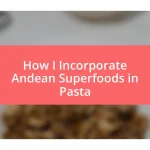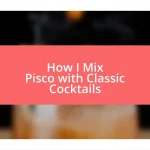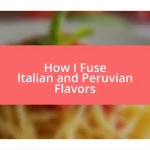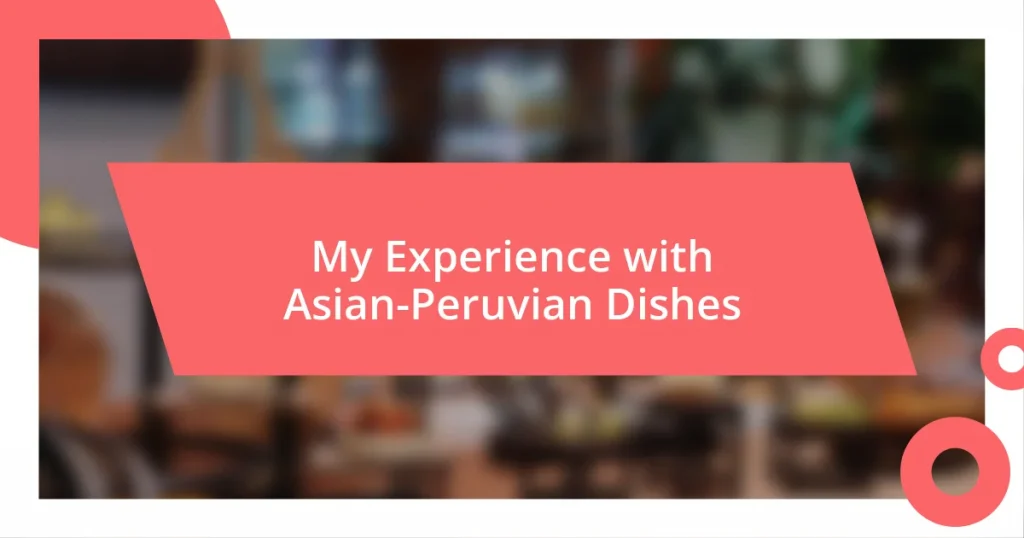Key takeaways:
- Peruvian cuisine is a rich fusion of Indigenous, Spanish, African, and Asian flavors, with key ingredients like aji peppers and diverse potatoes enhancing traditional recipes.
- Spanish culinary influences, such as rice, olive oil, and cured meats, blend with local ingredients to create innovative dishes, reflecting a deep historical exchange.
- Successful fusion dishes, like tallarines verdes with chorizo and quinoa-based paella, showcase the potential for creativity by combining elements from both cuisines while maintaining their unique identities.
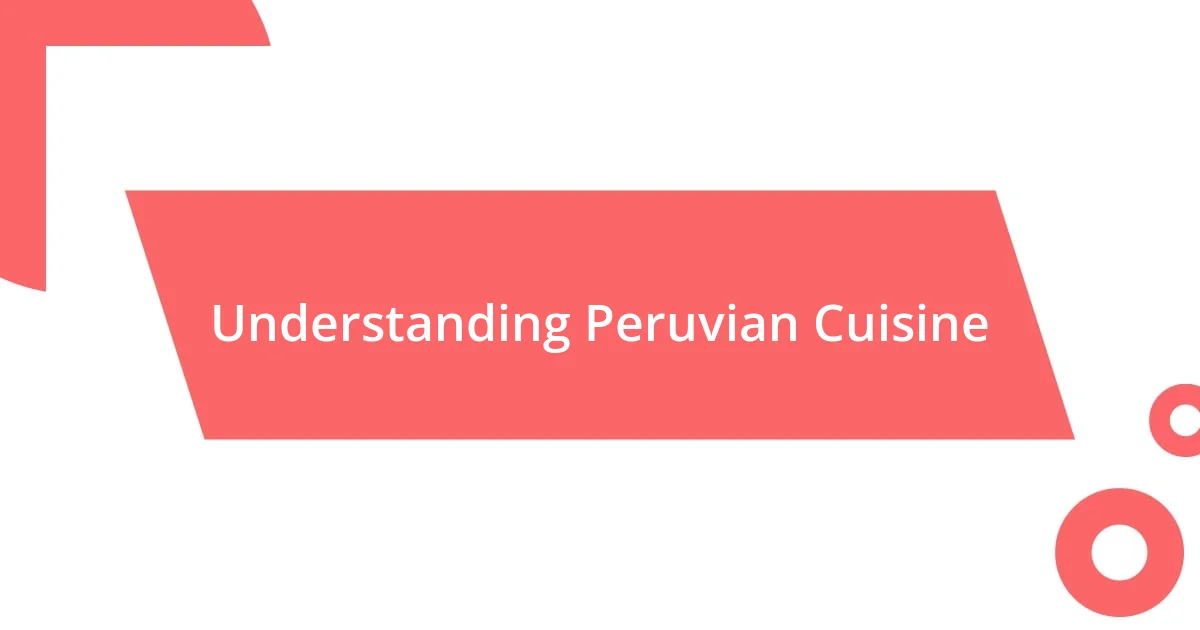
Understanding Peruvian Cuisine
Peruvian cuisine is a remarkable tapestry woven from diverse cultural influences, including Indigenous, Spanish, African, and Asian flavors. I remember the first time I took a bite of ceviche; the freshness of the fish combined with the zing of lime just felt like a burst of sunshine. How can one dish encapsulate so much history and warmth?
As I dived deeper into cooking Peruvian dishes, I discovered the importance of ingredients like aji peppers and potatoes. The sheer variety of potatoes—over 4,000 types—blew my mind! They taste different and offer unique textures, which makes them a perfect canvas for many traditional recipes. Isn’t it fascinating how a simple ingredient can elevate a dish’s complexity and depth?
Moreover, I’ve found that the balance of flavors in Peruvian dishes reflects the harmony found in Peruvian culture itself. When I experimented with making lomo saltado, it wasn’t merely about cooking; it was about capturing the spirit of Peru in my kitchen. Each layer of flavor—savory, spicy, and tangy—tells a story, and that’s what intrigues me most about this cuisine. What stories will your culinary journey unveil?
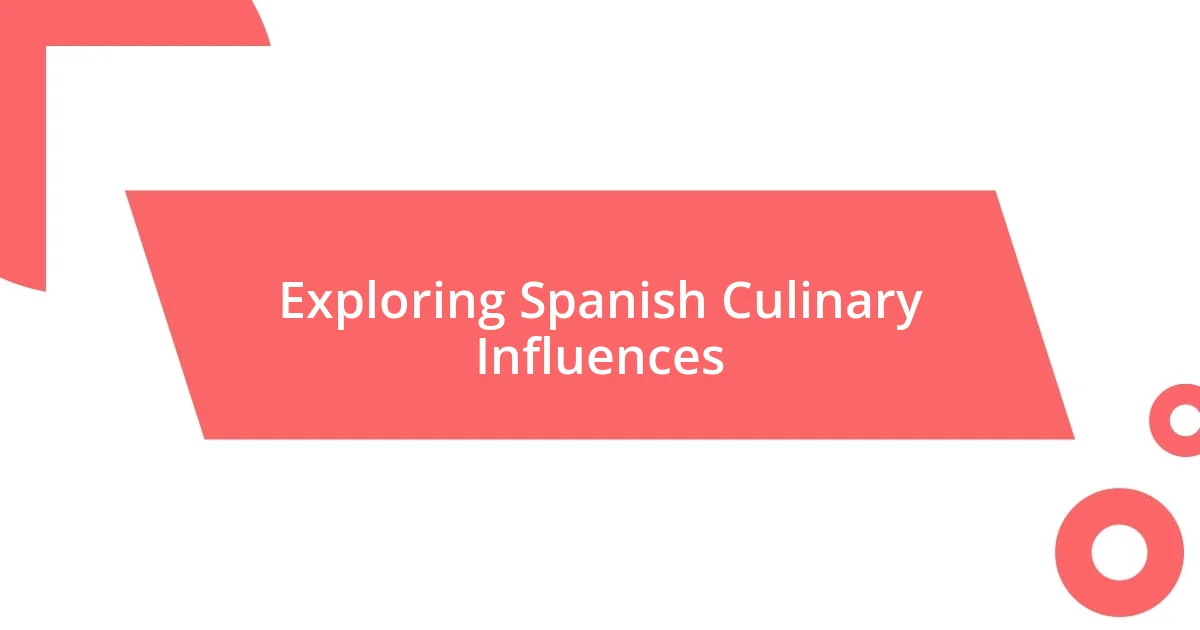
Exploring Spanish Culinary Influences
Spanish culinary influences have left a profound mark on Peruvian cuisine, transforming it into a rich blend of historical flavors. I still recall the first time I tasted a homemade Spanish tortilla at my friend’s house. The balance of tender potatoes and fluffy eggs sparked an idea—I wondered how I could infuse that comfort into my Peruvian dishes. This cross-cultural exchange allows for creativity, each ingredient telling its own story within the broader narrative of the dish.
Here are some key Spanish influences in Peruvian cooking:
- Rice and Beans: Staples brought by Spanish settlers that have been adapted into dishes like arroz con pollo.
- Olive Oil: A cornerstone in Spanish cooking, olive oil is often used in Peruvian gastronomy for sautéing and dressings.
- Cured Meats: Chorizo and jamón add a depth of flavor to Peruvian dishes, blending seamlessly with local ingredients.
- Herbs and Spices: Spanish spices like saffron join forces with indigenous herbs to create complex flavor profiles.
- Pastry Techniques: The art of making empanadas has Spanish roots, giving a unique twist to Peruvian snacks.
Each influence invites me to explore further, experimenting with seasonal ingredients to create something uniquely my own. It’s like having a culinary passport, allowing me to travel through time and space, bringing the past into my modern kitchen!

Identifying Ideal Fusion Ingredients
Identifying the right ingredients for melding Peruvian and Spanish flavors is an exhilarating adventure that truly engages the senses. For instance, when I sourced the unique Peruvian yellow aji pepper, it evoked memories of numerous gatherings filled with laughter and vibrant conversations. This pepper’s distinct warmth and sweetness help bridge the two cuisines beautifully and offer a fiery element that brings depth to dishes like a spicy paella. The thrill of discovering how such a singular ingredient can redefine a traditional Spanish recipe keeps me coming back for more experimentation.
On the flip side, I’ve found that incorporating ingredients from Spanish cuisine can elevate a Peruvian classic beyond its original charm. Recently, I tried adding Spanish chorizo to a classic causa limeña. The savory richness of the chorizo harmonized with the creamy avocado and lime, creating a dish that not only honored its roots but also showcased a blend of cultures. Each time I experiment, I’m amazed at how a simple substitution can evoke deep, layered flavors that tell a new story on the plate.
This intersection of flavors invites endless possibilities. For example, when thinking of fusion dishes, I often ask myself: “How can I amplify a culinary heritage?” I once made a fusion risotto using Peruvian quinoa instead of rice, further enhanced with saffron and topped with fried calamari. The textures and flavors were a delightful surprise, reminding me that exploring diverse ingredients can lead to innovative creations. Ultimately, the dance of these culinary elements speaks to a rich cultural tapestry that continually evolves.
| Peruvian Ingredient | Spanish Ingredient |
|---|---|
| Aji Amarillo (yellow chili pepper) | Chorizo |
| Quinoa | Spanish Rice |
| Peruvian Potatoes | Olive Oil |

Techniques for Flavor Combination
Combining flavors from Peruvian and Spanish cuisines often feels like crafting a vibrant tapestry of taste. When experimenting with a new dish, I often find myself reaching for fresh herbs like cilantro or parsley. Just the other day, I prepared a fusion ceviche, tossing in a handful of minced parsley along with the classic lime and aji. The herb not only brightened the dish but also injected a touch of familiarity, making each bite a delightful surprise intertwined with my culinary roots.
One technique I love to employ is the layering of flavors. Recently, I decided to elevate a traditional Spanish gazpacho by incorporating Peru’s iconic sweet potato. The sweet potato brought a silky texture that balanced the acidity of the tomatoes, creating a comforting yet refreshing summer soup. It made me wonder—how often do we limit ourselves to the expected when the unconventional can lead to transformative experiences? The blend of contrasting yet complementary flavors can open the door to unexpected culinary joys.
Experimenting with spices is another technique that fuels my creativity. Adding a sprinkle of smoked paprika to my causa was another culinary revelation. The spice’s warmth melded surprisingly well with the Peruvian potato base and zesty lime. It was a small change, yet the repercussions were striking—a little bit of history and a hint of new world flavor intertwined into something that felt entirely my own. Have you ever tried to spice things up in your kitchen? It’s amazing how a single ingredient can redirect the whole culinary conversation on your plate.

Balancing Authenticity and Creativity
Finding the right balance between authenticity and creativity in my Peruvian-Spanish fusion dishes has been an enlightening journey. I remember the first time I made a lomo saltado with a Spanish twist by using paella spices. The aromas that filled my kitchen sparked a curiosity that made me realize it’s essential to honor the essence of both cuisines. Have you ever faced that crossroads yourself? It’s a mixture of respect and experimentation that opens new culinary doors.
Whenever I dive into creating a dish, I reflect on what makes each cuisine unique. For instance, I once infused traditional Spanish empanadas with Peruvian ingredients like olives and rocoto sauce. The result was a flavor explosion that not only paid homage to both cultures but also transformed the familiar into something exciting. It made me question: can true authenticity exist when I’m constantly influenced by my own evolving tastes? Each time I blend elements, I feel a sense of ownership over the tradition while crafting a narrative that belongs solely to me.
Occasionally, I step back to evaluate the heart of what I’m doing. While originality is important, I also cherish the stories that classic recipes tell. When I first made a fusion tiradito inspired by Spanish romesco sauce, I found myself smiling at how past culinary experiences inform each new creation. It’s fascinating how flavors can narrate a journey across cultures, removing barriers while celebrating heritage. How do you immerse yourself in culinary traditions while breaking the mold? For me, the answer lies in that harmonious tension between honoring the old and embracing the new.
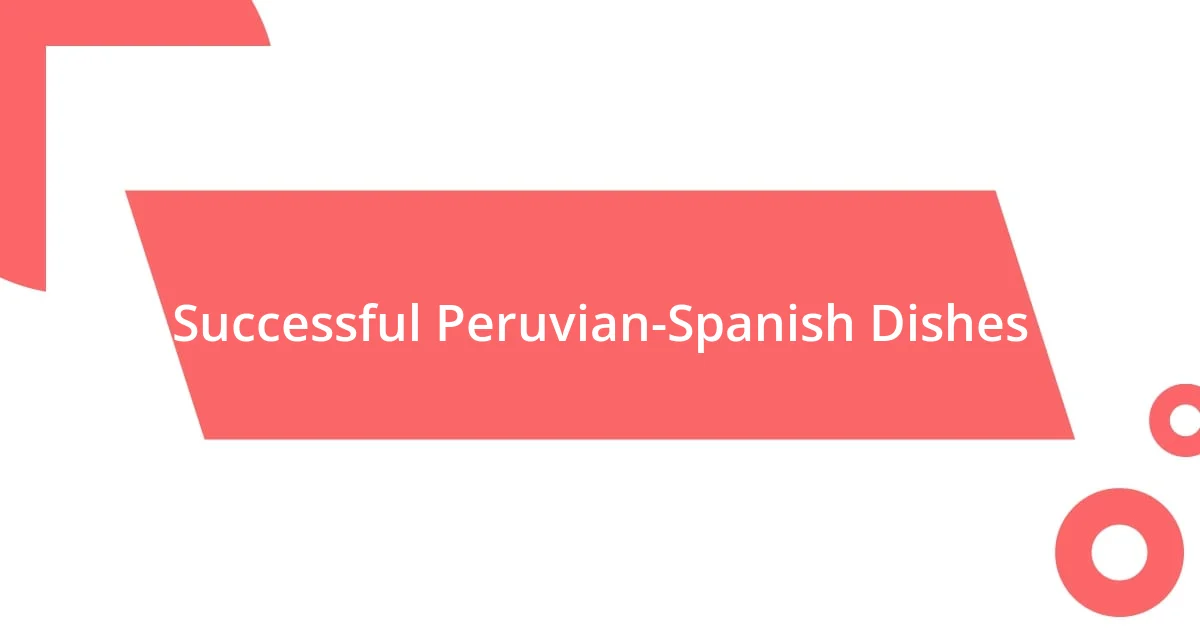
Successful Peruvian-Spanish Dishes
One of my favorite Peruvian-Spanish dishes is the fusion of tallarines verdes with chorizo. I remember the first time I took the traditional Peruvian green noodle dish and paired it with spicy Spanish sausage. The result was a comforting meal that danced between the creaminess of basil and the smoky kick of the chorizo. Have you ever experienced that moment when two beloved dishes collide beautifully on your plate? It’s magical how small adjustments can lead to new culinary adventures.
Another successful experiment was when I crafted a paella using quinoa instead of rice. The beloved Spanish dish transformed into something uniquely Peruvian, with vibrant vegetables and a hint of aji amarillo. The nuttiness of quinoa added depth, while the seafood brought out the coastal essence of both cuisines. I often think about how experimenting with traditional grains can elevate a dish. Isn’t it fascinating how a simple swap can create a whole new experience?
More recently, my exploration led me to create a fusion homestyle empanada filled with aji de gallina—an iconic Peruvian chicken dish. As I watched the dough puff up in the oven, a wave of nostalgia washed over me. The creamy, spicy filling paired perfectly with the flaky crust, creating an explosion of flavors that felt like home. Have you ever tried recreating a cherished family recipe with a twist? This melding of traditions not only honored my culinary roots but also invited new memories to be created around the dinner table.

Tips for Home Experimentation
Experimenting with Peruvian-Spanish fusion at home requires a spirit of adventure. I often start by identifying the staple ingredients in both cuisines that I love. One day, I noticed the remnants of a Spanish tortilla alongside leftover Peruvian causas in my fridge. What if I combined them into a layered dish? The result? A delightful playful brunch that not only satisfied my palate but also ignited a love for culinary experimentation. Have you ever looked in your fridge and thought, “What could I create today?”
Another tip I’ve found helpful is to focus on learning from the classics while still allowing room for creative tweaks. I vividly recall my first attempt at blending a Spanish gazpacho with Peruvian spices; the explosion of flavor was remarkable. I tossed in a few drops of limón and a sprinkle of cilantro, transforming a traditional dish into something uniquely mine. It taught me that even small alterations can breathe new life into beloved recipes. What classic dishes do you think could benefit from a little twist?
Lastly, I encourage you to invite friends or family into your kitchen to share in the experimentation process. I once hosted a fusion night where we crafted pizzas using Peruvian toppings, like aji de gallina and queso fresco. The laughter and creativity flowed, and it turned cooking into a joyful event rather than just a task. Sharing ideas and tastes can lead to unexpected inspirations—what new ideas might you discover when cooking together?




